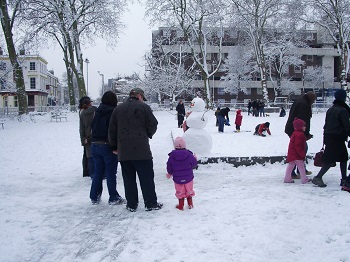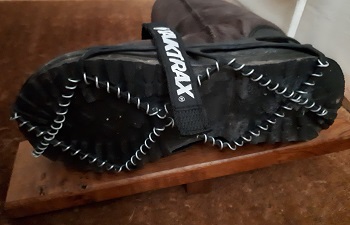Use the Alexander Technique While You Walk
Winter brings rain, fallen leaves, ice and sometimes snow on the ground, which can make our footpaths very slippery and treacherous. We need to walk with awareness on slippery paths in order to maintain an easy poise and balance.
You can see how quickly snow compacts into slippery ice, here on Newington Green – making it so easy to skid, slide and lose your balance, if you are not careful.
How do you cope with slippery surfaces and paths? If you are aware, you can notice your reactions as you think of going out into the cold – do you start becoming tense at the mere thought of icy conditions? Perhaps you can say ‘no’ to bracing and choose not to do that, so that you can avoid building up unnecessary tension. Observe how you walk on slippery surfaces and experiment by relaxing and being thoughtful about how you move – and you may well experience a different, easier way of walking on slippery surfaces so you feel more secure and confident.
Adding ice grippers to your footwear is a practical aid to helping you cope with icy conditions. They make it much easier to balance and to avoid tensing up if you have a fear of falling.
I know from my own experience that it is very tempting to tighten up our legs, feet and ankles, the muscles around our hip joints and even our neck and shoulder muscles when walking on slippery surfaces. Most of the tightening is the result of anticipating a possible fall and this can
be tiring plus restricts our movements and circulation – and it’s a waste of energy!
Say ‘No’ to Bracing!
We really don’t need to brace ‘just in case’ we might slip and fall. This doesn’t serve us. In fact, tightening our neck muscles reduces the information we can obtain about our balance, and locking our ankles and hips also interferes with our ability to fine tune our balance. A recent Research Trial concluded that Alexander Technique lessons aided older people with their balance and fear of falling, so that they felt more secure.
I remember an occasion when I was walking tentatively on an icy pavement and I was gradually getting very tight muscles around the tops of my legs – then a teenage girl sprinted down the icy road in front of me with beautiful grace and freedom of movement. Seeing her easy running skills reminded me to keep freeing up my neck muscles and my whole body as I moved and I felt a lot more comfortable as a result! When we do this, we are able to obtain more information about our balance, not only from the structures in our ears but also from the tiny movements our heads make as we walk and the AT can help us to do this. It is always helpful to walk mindfully but it is particularly important when paths are slippery.

